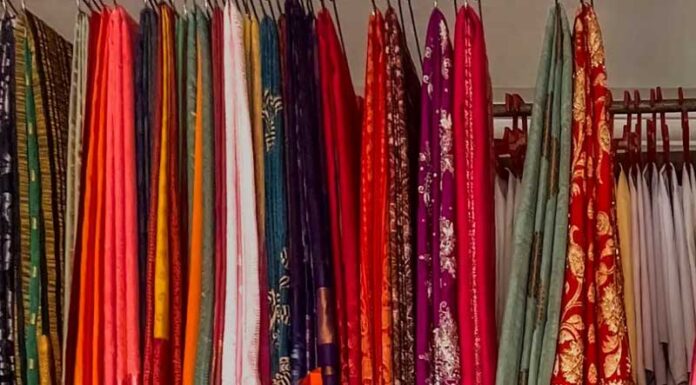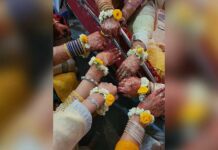By Annalisa Lewis
Imagine you’re in South India, a vibrant, loud, and bustling place, where vibrant traditions intersect with modernity. From the inner gullies to the main roads, you can find multiple saree shops lined right next to the street chai and chaat stalls, offering a variety of sarees catering to all budgets, from affordable to high-end options. These shops tend to come alive at night, all lit up and crowded with families. You can see small kids running around while the elders struggle to find the perfect saree for their occasions.
Gully: The term “gully” is a common Indian English word, derived from the Hindi word “gali”, which means a narrow street or lane. It’s a Hindi slang word.
Some states in South India relate the saree to a woman’s dignity, whereas to others it could be a part of their identity. The purpose of the saree originally was to highlight grace and femininity, protect women from the harsh weather conditions and to preserve their modesty. There are more than ten different varieties of sarees in the south of India with each state showcasing its own unique materials, designs and traditional ways of draping them. Although sarees are worn throughout India, the South Indian sarees are known for their intricate and exquisite craftsmanship, rich history and their endless allure. The intricate threads of these sarees not only weave together stories of tradition and artistry but also human connections.
Zari: It is an even thread traditionally made of fine gold or silver used in traditional Indian, Bangladeshi and Pakistani garments. This thread is woven into fabrics, primarily silk, to make intricate patterns and elaborate designs of embroidery.
The most famous example is the Kanjivaram silk saree, world-renowned for its rich silk and elaborate zari work. It originates from the city of Kanchipuram in Tamil Nadu, where women have been draping themselves in the Kanjivaram silk saree for generations. The saree is expensive as it is handwoven by skilled artisans, and the mulberry silk material gives it a lustrous and luxurious feel. This type of saree is said to symbolize grace, wealth and timeliness. One of my aunt’s personal favorites is the Kanjivaram saree as it’s luxurious and feels soft on the body. According to her, this saree type is unique due to its hand stitched borders. The designs on this saree are mostly inspired by nature, mythology, and traditional symbols; they are always colorful and eye-catching.
Then there’s the Sado saree worn by Mangalorean Catholic brides. Mangalorean Catholics weddings are a blend of western and Indian culture. Traditionally, at the wedding reception, the bride changes outfits, from the western white gown to the customary red saree known as Sado paired with white jasmine and orange marigold flowers adorned on their hair. This saree is made of finely woven silk embellished with the zari border. In some families this saree is passed down from mother to daughter as a generational heirloom.
Bai: This term is used widely across India with different meanings. Bai is commonly used to address a female maid. However, it is also a respectful suffix for females, mainly royals, like Rani Lakshmi Bai and Jodhaa Bai. In the language Marathi, Bai is used to address schoolteachers and is a sign of respect.
Another popular saree from South India is Kerala’s traditional white and gold Kasavu saree, easily identifiable due to its prominent golden borders. From a country that’s known for its bright colors and vibrant hues, this saree stands out with its subtle charm. Although it has the façade of a simple saree, it has a rich cultural heritage and a unique aesthetic. The Kerala saree is very minimalistic because it is mostly white in color with little to no patterns. In the past, patterns were considered a crime, resulting in these subtle yet special handloom-sarees. Kasavu sarees were only worn by rich aristocrats and royalty. Commoners could only wear colored sarees at the time. Thoughts as to why the sarees are predominantly white could be linked to the prominent gold jewelry culture in Kerala. Most people felt the clothing didn’t need to be heavily patterned as they’d adorn themselves with heavy gold jewelry.
An interesting thing I’ve noticed in my hometown, Bangalore, the bais are always draped in sarees. Most households in India tend to have bais for cooking and cleaning. They generally wear old sarees as that’s what they feel comfortable in. Foreigners relate sarees to festive events and glamour; however, it’s also worn casually. The sarees they wear are softer and simpler, generally faded over time due to overuse. Traditional sarees offer comfort, affordability and versatility, making them suitable for household tasks. Additionally, the choice of traditional sarees may reflect societal norms and personal preferences, emphasizing a sense of dignity and respect for their roles within the household.
Although in India, an array of sarees exists, each state boasts its unique style, reflecting its identity. In addition, there’s no one perfect way of draping a saree. Right now, there are about 100 different kinds of draping styles, depending on region, fabric, length and width of the garment, and if the wearer wants to look slim. The younger generation trying to stay in touch with their culture has also been experimenting with saree styles. Choosing the perfect saree is not simple. It’s like a complex dance of tangoing through different stores and tailors given the variety available. This piece of clothing has and always will be iconic to India. The saree is always evolving, showing just how important and beautiful it is.


















